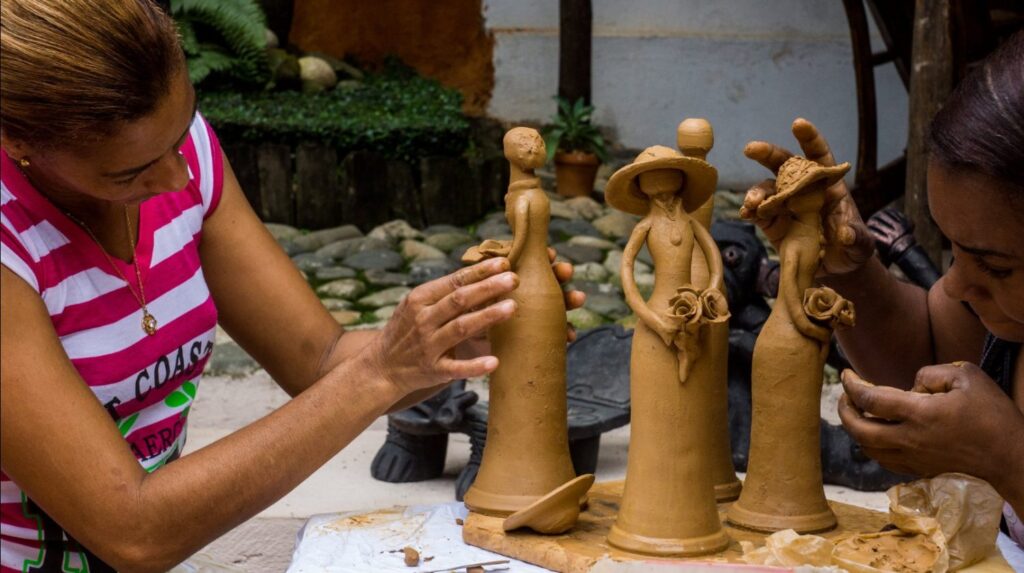
Santo Domingo.- Both foreign and national tourists find a wide array of attractions in the Dominican Republic, with handicrafts being one of them. The artisans, many of whose creations are imbued with history and legends, invite visitors and collectors to take home a piece of this land.
In an increasingly globalized world, the traditions and folklore of peoples are under constant threat. Handicrafts, for example, must compete with cheaper, mass-produced items from Asia. Hence, it is imperative to protect and defend this noble craft at all costs to preserve the cultural identity of communities that have passed down skills and knowledge from generation to generation for centuries.
Dominican craftsmanship reflects the country’s rich culture and diversity. Despite current challenges, it remains an integral part of the national economy and a source of pride. With proper investment and support, along with a strategic vision, Dominican handicrafts have the potential to flourish further, benefiting artisans, local communities, the tourism sector, and the economy in general.
From faceless dolls to larimar jewelry
Dominican handicrafts express popular culture, blending indigenous, Spanish, and African influences. An emblematic symbol of Dominican identity is the “faceless dolls” from Moca, with variants in other locations (Bonao, Baní, and San Cristóbal). Their lack of facial features signifies the mixed heritage that defines the Dominican people. These clay dolls represent anonymous working women, their figures of coffee, fruit, and flower sellers reflecting daily life.

El Higüerito, Moca, Dominican Republic. (Photo: Presidencia.gob.do)
In pottery, hand-modeled pieces with Taino motifs are popular in Jarabacoa, La Vega, and Monte Plata. These include cemíes, vessels, and jugs inspired by anthropological studies. Noteworthy for their quality are the “Chavón houses,” small ceramic houses inspired by the facades of Altos de Chavón.
Woodwork includes pilones, canoes, trays, tables, chairs, rocking chairs, musical instruments and numerous decorative and utilitarian pieces. Basketry, made from natural fibers, is equally widespread. In jewelry, amber and larimar (blue pectolite) pieces stand out, the latter being a semi-precious stone found only in Barahona, Dominican Republic, valued for its mesmerizing blue hues.
A resounding yes to local handicrafts
Sustainable development also hinges on considering local products, crafted by local artists with materials often sourced from nature, embodying pure heritage. The role of the artisan in the economy and tourism should be defended at all possible levels.
It’s vital for society to recognize the value of handicrafts as a cultural expression of the people and to treat them with the respect they deserve. One way to achieve this is by promoting artisanal products. It is crucial to make new generations aware of what local craftsmanship represents: a dignified form of work that preserves the traditions and spirit of a people, its culture and its roots.
Supporting artisans in marketing their products and providing comprehensive training is another step in elevating handicrafts in tourism. This includes helping them learn production techniques, marketing and design, as well as opening doors for them at national fairs and offering opportunities to participate in international fairs (participation in FITUR, Spain, has not gone unnoticed). Higher product quality leads to better recognition from visitors and collectors.
Dominican handicrafts have great potential to contribute to sustainable development. Many artisans are adopting eco-friendly practices, using recycled or sustainable materials and promoting traditional techniques that respect the environment. These practices help preserve the environment and add value to products in a globally conscious market.
It is essential to establish policies that protect local handicrafts to combat mass-produced and fraudulent items that threaten the authenticity of Dominican craftsmanship. Mandatory certification of artisanal products and sanctions for selling uncertified pieces are necessary.
Although Dominican craftsmanship has seen significant increases in quality and artisan participation, only 20% of the handicrafts sold to tourists are of Dominican origin, with the remaining 80% made abroad.
A report from the newspaper Hoy, dated January 6, 2024, indicates that the Dominican Republic exports handicrafts to more than 15 countries, providing income to around 40,000 families. However, the Ministry of Tourism’s (Mitur) resolution requiring that 80% of handicrafts sold be locally produced is not being enforced, prompting artisan guilds to call on the state to gradually increase the percentage of local handicrafts in the market.
Craftsmanship, an ally of volunteer tourism
Solidarity, inherent to human nature, also manifests in the handicraft sector. A notable example is Esther Mendioroz from Sangüesa, Navarra, Spain. Her spirit of solidarity led her to Santo Domingo in late May 2008, where she used her talent to enrich the lives of low-income Dominican women.
Without hesitation, she crossed the Atlantic. In the Primada de América, she was welcomed by a Navarrese priest from the order of Saint Vincent de Paul, who organized her stay and activities in Los Mina, a disadvantaged neighborhood in the eastern part of the Dominican capital. Esther brought fabrics, scissors, sewing materials, pattern magazines and other supplies gathered thanks to the enthusiasm of her workshop students in Sangüesa, who held charity markets to raise funds.
In a conversation with Dominican Today, Esther fondly recalls those magical moments in this half-island: “That experience remains in my memory with infinite affection. It’s hard to describe the satisfaction of helping people with few resources. Those women welcomed me with open arms. I taught them to do what I love most, and I think I managed to open a world of possibilities for them.”

Images from classes given by Spanish artisan Esther Mendioroz in Los Mina, Santo Domingo, Dominican Republic, in June 2008. (Courtesy of Esther Mendioroz)
She taught patchwork classes, a sewing technique popular in Anglo-Saxon countries that reuses fabric scraps to create new pieces. She had four groups of 20 women each, and the conditions were not optimal, with only two manual sewing machines and no ironing due to lack of electricity. There was also a shortage of scraps or old clothes for new creations.
Despite the challenges, the Dominican students learned to make bags, cushions, colorful brooches and other crafts over a month, which they later sold. One of them even managed to open a small store in the area to sell her creations, Esther recalls.
Handicrafts, whether as part of artisanal tourism or as an excuse for volunteer tourism – as in the case of Spanish Esther Mendioroz – combine the utilitarian and the aesthetic, standing as a bulwark of cultural resistance and a symbol of the patrimonial wealth of peoples.

Esther Mendioroz and Anita González Sigler in the Colonial City of Santo Domingo, in June 2008. (Photo: courtesy of Anita González Sigler)
_________________
By Anita González Sigler
Reporter, writer, designer and artisan
lunaparche@gmail.com





